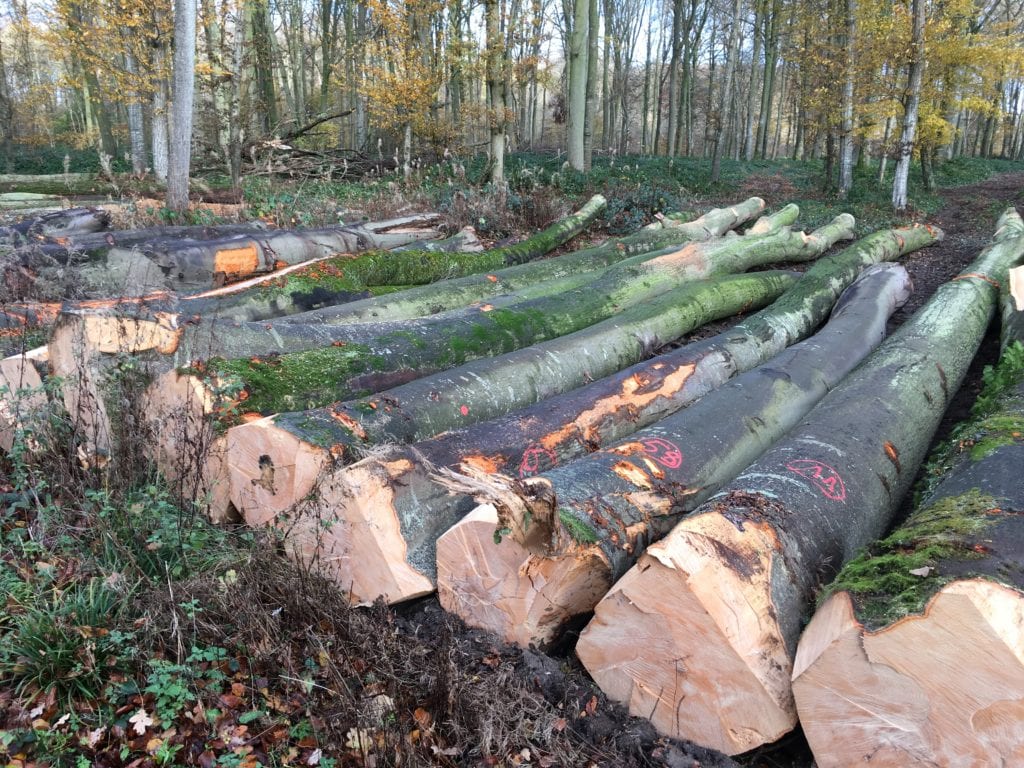Ensuring the Conscious Use of Timber
By Dave West
How many of us who work with machined timber take notice of the trees that we must, initially, cut down? How many of us walk amongst the trees but do not look up at their beauty? How many of us actually pay attention to how much of the tree we do not use?
Dave West here. As a director of WLW for many years, I’d like to draw attention to the impact of a wide range of processes on the timber we fell and manufacture.
Only 15% of an Oak Tree Used in the UK
Let us take the UK’s most popular temperate tree: Oak.
A staple of the hardwood industry, Oak is strong, durable, and the timber is beautiful when finished, growing up to 30 metres tall in the UK, potentially up to 45 in some areas of Europe.
Say we choose a fine oak tree and select it for felling. The canopy of an oak tree can be over 25-35 metres wide and can weigh over 20 tonnes. With a potential diameter of say, 700mm, we might use 8 metres of the tree (given the right quality) for plank.
That equates to 3.079 cubic metres – roughly 3 tonnes. This means that 15 to 17 tonnes of the tree is of no use to our part of the industry. Although each part of unusable timber is recycled for different purposes, we use an astonishingly low 15% of the tree.
Fortunately, there are still markets for the remainder of the tree, but this consists mainly of biomass, wood shavings and slabwood. You’d think the firewood market would feature in the list of beneficiaries as well; however drying Oak is more time consuming that other species and, so, is less popular.
Sawmill, Plank and Air-Dried Oak
Having taken our oak tree from the ground, we now have our log, which we then send to our sawmill for the planking process.
To illustrate this next stage, we will cut our log into 27mm waney-edged plank using a log bandsaw with a 2mm blade. (Remember, this is a hypothetical scenario and every tree is different, so we are thinking about a pretty perfect specimen here).
Two boards from the top and bottom will be cut off to make a flat surface – this is called slabwood. We have allowed 85mm thickness for each of these pieces, so 170mm in total.
Given that each board has to be cut 7% thicker than the finished size to allow for shrinkage during drying, an estimated 18 saw cuts later will see another 36mm of `waste’. So far, we have cut 17 boards, for a total thickness of 493mm, having reduced the useable timber by 30% from the original 700mm diameter.
Of the original tree, then, we are down to just over 10%!
Sawmillers then have to air-dry the timber for 1 year per 27mm thickness to bring the moisture content down to around 26%, before kilning down to 12% (+- 2%). During this drying process, we lose another 7% in thickness, and about 0.5% in length.
Machined Oak
So, we now have a fantastic boule of Oak ready to be machined, sawn, planed, sanded and cut to size by a multitude of skilled tradesmen.
But every saw cut, planer blade and piece of sandpaper in the next part of this tree’s journey will result in yet more loss of volume.
The end result, of course, is strong machined timber. Beautiful, no doubt, but remember: each plank represents so much more than a slab of wood.
The whole of an oak tree adds up to more than just the sum of its parts and must be appreciated as such.
A More Conscious Use of Timber
Far from discouraging the use of beautiful timber, W. L. West & Sons Ltd simply want to increase awareness around the manufacturing process of each tree. Trees are renewable, of course, but older and nobler than we are equipped to understand. An oak tree that has stood for some 100 years and has seen a wide stretch of history pass it by, then been reduced to a comparatively small amount of timber, deserves to have its story told.
As a company, we consider ourselves environmentally conscious. From the start of our business, and as of September 2020, our recycling measures are regular and successful. These involve supplying shavings and wood dust for animal bedding, or slabwood for biomass and smaller offcuts of firewood.
We should pay more attention to the wonderfully renewable resource that we use in our industry. We should make sure we try to use as much of each felled tree as possible.
Perhaps is no small consolation, at least, that the small part used in a fantastic piece of joinery or furniture will be here for another hundred years.
Author: Dave West
WL West & Sons Ltd is a timber merchant and sawmill business with 150 years of experience. We provide an extensive range of timber products and supplies, including hardwoods and softwoods. We also build and install custom projects for our customers.
For more news, tips and updates, follow us on Facebook, Twitter, or Instagram.
For entirely finished products, timber supplies or woodworking tools, have a look at our Retail Shop.
Liked this article? More like this:
Best Woodworking Machinery – The MEBOR HTZ 1400 Extreme 20 Sawmill
9 Things You Need to Know About Beech Wood







